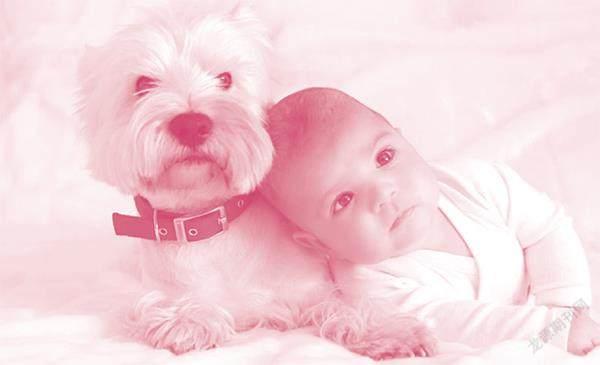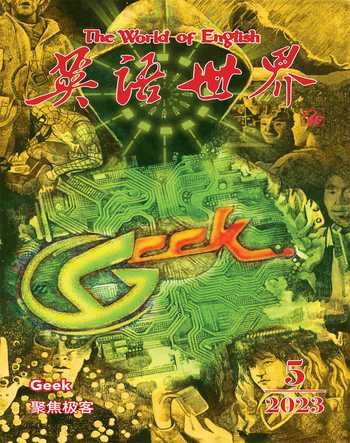Why You Want to Squeeze Adorable Babies and Puppies人为什么爱捏萌宝萌犬
2023-05-19凯尔西·伯雷森郭硕/译
凯尔西·伯雷森 郭硕/译

When my youngest sister was a baby, I recall telling my mom through gritted1 teeth: “Ugh, shes so cute, I cant stand it. I just want to squeeze2 her!”
记得小妹妹还是个宝宝时,我曾咬着牙跟妈妈说:“呀,太可爱了吧,忍不住想捏一捏!”
Years later, I still feel this overwhelming pull to squeeze adorable things: when my son belly-laughs, when my puppy rests his perfect little head on my lap or when I think about Baby Dory3.
多年后,看见可爱的东西我还是有一种抑制不住想捏一捏的冲动,比如儿子捧腹大笑的时候,狗狗可爱的小脑瓜搭在我腿上的时候,或者想到幼年多莉的时候。
This burning desire to playfully squeeze, bite, pinch or growl4 at cute things—without any actual intention to harm—is called “cute aggression.” Social psychologist Oriana Aragón and her research team at Yale University gave this phenomenon its name.
社会心理学家奥丽娅娜·阿拉贡和她耶鲁大学的研究团队把这种看见萌萌的东西就迫切地想要捏一捏、咬一咬、掐一掐或低吼一声,但实际上无意给对方带来伤害的现象命名为“萌系攻击冲动”。
Lest5 you feel like some kind of weirdo6 for feeling this way, it turns out cute aggression is actually quite common. Aragón estimates that 50% to 60% of the population experiences it.
不必为拥有这种感受而觉得自己有点儿怪,其实萌系攻击冲动非常普遍。据阿拉贡估测,50%到60%的人都有过这样的冲动。
Cute aggression is an example of what researchers call “dimorphous7 expression”—when your internal feelings and the outward expression of those feelings seem to contradict one another. Other examples might include crying during joyful moments, like a wedding or the birth of a child, or laughing during an uncomfortable conversation.
萌系攻击冲动是研究人员所说的“二态表达”的一个例子。二态表达是指人的内在情绪和外在表现看似矛盾的现象。其他的例子还有在婚礼、宝宝出生等场合喜极而泣,或是在别扭的谈话中哈哈大笑。
Aragón and her Yale colleagues hypothesized that because dimorphous expression seems to occur when a person is overwhelmed with emotion, cute aggression could be a mechanism to help regulate these intense feelings. And they found some evidence to support that.
阿拉贡和她耶鲁的同事们推测,既然二态表达似乎是在人情绪激动时才出现,那么萌系攻击冲动就可能是一种帮助调节强烈感受的机制。他們也找到了一些相应的佐证。
In their study, which was published in 2015, participants viewed photos of babies with more infantile8 features (digitally altered to have larger eyes and cheeks and smaller noses) and less infantile features (manipulated to have smaller eyes and cheeks and larger noses). Then they were asked to rate how strongly they agreed with statements such as “When I look at this baby, I feel like I am overwhelmed by very strong positive feelings”; “I feel like pinching those cheeks”; and “I feel like I want to take care of it.” Participants were also asked to gauge9 their emotional state before and after they were presented with the images.
在他们2015年发表的一项研究中,被试人员观看了婴儿特征较为明显的宝宝照片(通过数字化手段呈现出大眼睛、胖脸颊、小鼻子的宝宝)和婴儿特征不够明显的宝宝照片(把照片中的宝宝眼睛变小、脸颊变瘦、鼻子变大)。然后要求他们判断对一些表述的认同程度,比如,“看到这个宝宝有非常强烈的正面感受”“想掐一掐这些脸蛋儿”“感觉想照顾这个宝宝” 。被试人员还应要求评判自己观看照片前后的情绪状态。
Researchers found that the people who experienced feelings of cute aggression did “come down off the ‘cute high faster,” Aragón, now an assistant professor at Clemson University, told HuffPost. “They got really amped up10 with the cuteness” and then returned to a baseline state more quickly than those who didnt experience cute aggression.
研究人员发现,体会过萌系攻击冲动的人的确能够“更快从‘萌嗨的情绪中恢复过来”,目前在克莱姆森大学任助理教授的阿拉贡接受《赫芬顿邮报》采访时说道,“他们看见可爱的东西会非常兴奋”,但是恢复到常态要比那些没有体会过萌系攻击冲动的人更快一些。
“It might be that this countervailing11 expression helps to tamp12 down the experienced emotion,” Aragón said.
“可能是这种抗衡式的表达有助于平复他们的情绪。” 阿拉贡如是说。
From an evolutionary standpoint, this makes sense. Research has established that infantile features encourage caretaking behaviors in adults.
從进化论的角度看,这也有其道理。研究已经证实,婴儿的幼年特征可以激发成年人的照顾行为。
“Ultimately, the babys well-being is served by cuteness eliciting both expressions of care and of aggression, because if the expresser is no longer incapacitated with overwhelming positive affect, that person may be better able to care for the baby,” the authors wrote in the study.
“归根结底,激发照顾和攻击这两种行为的可爱特征能够让婴儿得到好的照料,因为受激发者若得以表达强烈的积极情绪,可能会更好地照顾宝宝。”研究人员在报告中写道。
Interestingly, Aragón and her team also found that people who experience cute aggression are more likely to express emotion in a dimorphous manner across a variety of emotionally charged situations. In other words, those who want to pinch a babys chubby cheeks tend to be the type to cry at weddings, too.
有趣的是,阿拉贡和她的团队还发现,体会过萌系攻击冲动的人更有可能在各种心情激动的场合以二态的方式表达情绪。换言之,那些想掐一掐宝宝胖乎乎脸蛋儿的人也会是婚礼上哭泣的那一类。
Katherine Stavropoulos, a clinical psychologist and researcher at the University of California, Riverside, has also studied cute aggression. She primarily studies brain activity in kids with and without autism13, with a focus on the reward system.
加利福尼亚大学河滨分校研究员、临床心理学家凯瑟琳·斯塔夫罗普洛斯对萌系攻击冲动也有研究。她主要钻研自闭症儿童和非自闭症儿童的大脑活动,专注于大脑的奖励系统。
Stavropoulos co-authored a study, published in 2018, that looked at what happens in the brain when you feel cute aggression. They ultimately found that the phenomenon involves both the brains emotional system and its reward system, which is responsible for feelings of wanting and pleasure.
斯塔夫罗普洛斯作为共同作者参与完成了一项2018年发表的研究,该研究探索了人们在感受到萌系攻击冲动时大脑的活动。结果显示,萌系攻击冲动与大脑的情绪系统和奖励系统都有关联,奖励系统负责的是激发渴望感和愉悦感。
In the study, participants looked at images of “cute” and “less cute” babies (the same ones Aragón used in her study), and “cute” and “less cute” animals (i.e., baby animals vs. adult animals). After viewing the photos, the participants rated how strongly they agreed with statements expressing cute aggression (e.g. “Its so cute I want to squeeze it!”) and feelings of overwhelm (“Its so cute I cant handle it”), among others. Electrode caps14 measured electrical activity in different parts of the participants brains.
在該研究中,被试人员观看了“可爱”和“不够可爱”的宝宝照片(和阿拉贡研究中使用的照片相同),以及“可爱”和“不够可爱”的动物照片(即动物幼崽和成年动物的照片)。看完照片后,被试人员评估了自己对萌系攻击冲动相关描述的认同程度(如,“太可爱了,好想捏一捏!”),对强烈情绪相关描述的认同程度(“可爱得让人受不了”),等等。还使用电极帽测量了被试人员大脑不同部位的脑电活动。
“The people that rated agreeing with the feeling of, ‘Its so cute, I want to squeeze it, were the people with the most reward-related brain activity,” Stavropoulos said.
“那些认同‘太可爱了,好想捏一捏感受的人也是大脑活动中奖励系统最为活跃的人。”斯塔夫罗普洛斯说。
Stavropoulos hopes to continue research in this area to see how people with autism and postpartum15 depression experience cute aggression, and what differences might exist between people who have kids or pets and people who dont. For example, what if cat owners felt more cute aggression toward kittens, and parents (or people who want to have children) felt more cute aggression toward babies, than those without kids did?
斯塔夫罗普洛斯希望继续在该领域深耕,探究自闭症患者和产后抑郁患者是如何经历萌系攻击冲动的,以及有孩子或宠物的人与没有孩子或宠物的人之间有何区别。比如,养猫的人是否看见小猫咪时感受到更多萌系攻击冲动,而有孩子的人(或期望有孩子的人)相比没有孩子的人,是否看见小宝宝时感受到更多萌系攻击冲动。
“Its interesting to me, the role that that experience could play in cute aggression or, just in general, our development of these overwhelming emotions,” Stavropoulos said.
“这种养育体验在萌系攻击冲动中,或者概括地说,在这些强烈情绪的形成中起到了什么作用,对此我很感兴趣。”斯塔夫罗普洛斯说道。
(译者为“《英语世界》杯”翻译大赛获奖者;单位:天津铁道职业技术学院)
